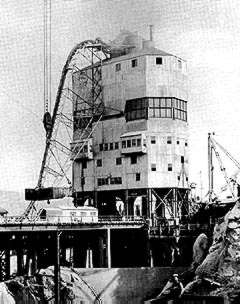|
Subscribe / Renew |
|
|
Contact Us |
|
| ► Subscribe to our Free Weekly Newsletter | |
| home | Welcome, sign in or click here to subscribe. | login |
This Century's Top Ten Construction Projects
|
|
Grand Coulee still the mightiest of them all
'And on up the river is Grand Coulee Dam. . . The mightiest thing ever built by a man.'Dates: 1933-1983Cost: $1.1 billion Contractor: MWAK and Consolidated Builders Inc. Amazing Fact: There is enough concrete in the dam to build a standard six-foot sidewalk around the world at the equator. No human endeavor has altered the Northwest as much as Grand Coulee Dam. While it is the Puget Sound region's high-tech economy that today is the focus of commerce in the Northwest, it was harnessing the Columbia River's might that made the region an economic powerhouse. And Grand Coulee Dam which at 12 million cubic yards of concrete is the largest concrete structure in the United States was the cornerstone of the engineering feat.
"It's difficult to choose among such a significant mix of power," wrote reader Steve Goldblatt, a University of Washington professor. "Most influential? Grand Coulee." The dam even is immortalized in Washington state's official folk song, "Roll On, Columbia, Roll On," by legendary balladeer Woody Guthrie. In one verse Guthrie succinctly explains the momentousness of the dam:
The mightiest thing ever built by a man To run the great factories and water the land So roll on, Columbia, roll on." DJC readers cited the immense significance of the dam. Ron Egge of Wilder Construction called it "one of the most economically beneficial construction projects ever built in the world." Not everyone, however, hailed the project. One reader, Rob Pruitt of the Austin Co., called Grand Coulee Dam "one of the worst affronts to the environment of this century" and wrote that it helps irrigate land that "should never have been irrigated." William M. Clapp, an attorney from Ephrata, first proposed damming the Columbia below the Grand Coulee in 1917, according to the U.S. Bureau of Reclamation, which manages the dam. Initially, the dam's primary purpose was irrigation. Work progressed slowly. Studies were done in the 1920s, and the federal Corps of Engineers issued in 1931 a report favoring construction. The world was mired in the Great Depression, and politicians viewed the dam as an economic development bonanza.
The dam is 46-stories high and runs the length of 14 city blocks. With 11.25 million cubic yards of concrete enough to pave a 16-foot-wide highway from Seattle to New York it is the world's largest concrete structure. Of the thousands of laborers, 81 died. By 1941, the main dam was essentially finished. At the time irrigation took a back seat because of World War II. The electricity generated by the dam was used to fuel the Northwest's aluminum industry, a vital cog in the war effort. Work resumed on the irrigation component after the Allies vanquished the Axis powers. Today, Grand Coulee Dam irrigates 500,000 acres of farmland in the Columbia Basin, and it can generate nearly 6.5 million kilowatts of electricity, making it the largest hydroelectric producer in the U.S. The dam's other asset is that it regulates the Columbia's highly variable flow and provides flood control. So roll on, Columbia, roll on.
 djc home | top | special issues index
|


